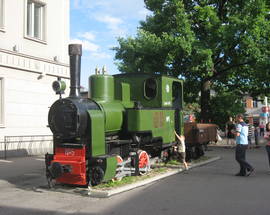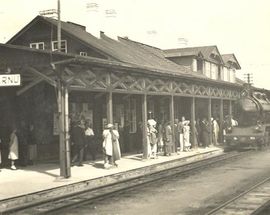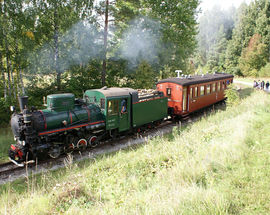Railway history
more than a year agoTo first-time visitors to the Summer Capital, the presence of a train monument at this particular spot might seem odd. This is the bus station, after all. There are no tracks in sight, and a quick check of the map shows that Pärnu’s railway station (which sees but two trains a day) is kilometres out of the centre. Pärnu just doesn’t seem like a railwayoriented town.
But this wasn’t always the case. In fact, there was a time when the downtown area was buzzing with railroad activity. With a keen eye and a little direction, train enthusiasts, or anyone interested in exploring local history, can find some fascinating traces of Pärnu’s railway past.
The abovementioned locomotive is the best place to start exploring. Its location actually couldn’t be more appropriate. The open area where bus station’s passenger platforms now stand was once the site of Pärnu’s original train station.
As the memorial’s brass placard explains, the town’s railway history started on October 5, 1896 when a narrow-gauge feeder line opened between here and Valga. Created by a private company, the line carried passengers, but was mainly used to transport cargo from this timber-rich part of the country.
The next year the line extended to Viljandi, and in 1900, a connection to Tallinn was established. Around this time, narrow-gauge lines were spreading all over the country, and by 1939, more than 909km of feeder lines crisscrossed Estonia.
Prewar maps of Pärnu show the entire area between nearby Pikk tänav and the river covered with tracks, depots and other railway buildings. From here tracks followed what is now Suur-Jõe street, and in some spots the street still rises up where the tracks’ embankment once ran.
War and the Soviet occupation brought inevitable changes. Pärnu’s station house didn’t survive the 1944 Soviet bombing. Some other buildings did though. The long, low buildings just across Pikk were part of the original, prewar infrastructure. From 1960 to 1967 they were used again when the passenger station moved to this area.
Anyone poking around that area can see the remains of the platform used at the time. Look hard and you might see an old railway wagon rusting nearby. Shoppers arriving at the Port Artur 2 centre seem completely unaware that they’re parking their Audis in what’s essentially an old train yard.
In the 1960s and 70s, the Soviet Union dismantled the narrow-gauge infrastructure in Estonia, favouring a uniform plan of wide-gauge tracks. A new Tallinn-Riga line, which bypassed the city centre, was opened in 1971. The last narrow-gauge train rolled out of Pärnu central in 1972, and the tracks were removed. They’re not completely gone though. According to Aldur Vunk, director of the Pärnu Museum, much of that infrastructure was carted off by thrifty locals to use as building material. Somewhere within the walls of their houses are long, iron rails still bearing the late 1800s date and the mark of Barrow, England, where they were made.
Other remnants of the old system, Vunk points out, are a few railway servicemen’s buildings, which still stand near the Rimi Hyper market at Papiniidu 4.
Visitors with a special interest in trains who are willing to go even further afield should make their way to the Lavassaare Museum Railway. It takes a 24km trip out of town and a little navigating, but it’s worth the effort. Started in the late 1980s by engineer Mehis Helme and two other enthusiasts, it has grown into the third largest railway museum in Europe by its number of cars. Here visitors can see locomotives and cars from a variety of countries, including Helme’s personal favourites: the pre-1920s rolling stock and the stock produced in Estonia in the 20s and 30s. After a journey out here, visitors will begin to understand that Pärnu’s railway history isn’t just a subject for dusty old books. It’s something that was elemental to the town and still echoes loudly after all these decades.







Comments